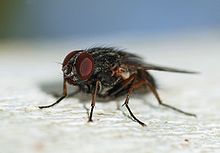
Forensic entomology is the scientific study of the colonization of a dead body by arthropods. This includes the study of insect types commonly associated with cadavers, their respective life cycles, their ecological presences in a given environment, as well as the changes in insect assemblage with the progression of decomposition. Insect succession patterns are identified based on the time a given species of insect spends in a given developmental stage, and how many generations have been produced since the insects introduction to a given food source. Insect development alongside environmental data such as temperature and vapor density, can be used to estimate the time since death, due to the fact that flying insects are attracted to a body immediately after death. The identification of postmortem interval to aid in death investigations is the primary scope of this scientific field. However, forensic entomology is not limited to homicides, it has also been used in cases of neglect and abuse, in toxicology contexts to detect the presence of drugs, and in dry shelf food contamination incidents. Equally, insect assemblages present on a body, can be used to approximate a given location, as certain insects may be unique to certain areas. Therefore, forensic entomology can be divided into three subfields: urban, stored-product and medico-legal/medico-criminal entomology.

The Calliphoridae are a family of insects in the order Diptera, with almost 1,900 known species. The maggot larvae, often used as fishing bait, are known as gentles. The family is known to be polyphyletic, but much remains disputed regarding proper treatment of the constituent taxa, some of which are occasionally accorded family status.
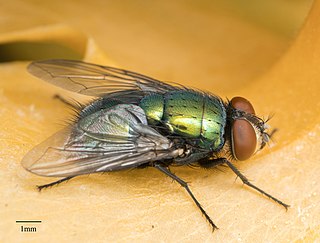
The common green bottle fly is a blowfly found in most areas of the world and is the most well-known of the numerous green bottle fly species. Its body is 10–14 mm (0.39–0.55 in) in length – slightly larger than a house fly – and has brilliant, metallic, blue-green or golden coloration with black markings. It has short, sparse, black bristles (setae) and three cross-grooves on the thorax. The wings are clear with light brown veins, and the legs and antennae are black. The larvae of the fly may be used for maggot therapy, are commonly used in forensic entomology, and can be the cause of myiasis in livestock and pets. The common green bottle fly emerges in the spring for mating.

Chrysomya putoria, also known as the tropical African latrine blowfly, is a fly species belonging to the blowfly family, Calliphoridae.C. putoria is native to Africa and has recently spread to the Americas. These flies pose significant health risks, especially due to their close association with human settlements. Adult flies can carry pathogens, while larvae may cause myiasis by growing and feeding on the flesh of domestic animals and humans. Other myiasis-causing flies in the same genus are C. bezziana and C. megacephala. C. putoria and other flies that feed on decomposing tissue are used as important tools in forensic entomology to establish the post-mortem interval, or the time elapsed since death.
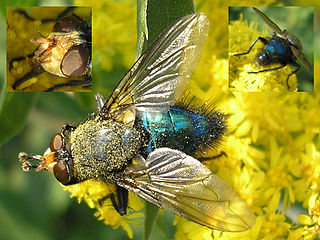
Cynomya mortuorum belongs to the order Diptera, sometimes referred to as "true flies". In English, the only common name occasionally used is "fly of the dead". It has a bluish-green appearance, similar to other Calliphoridae and is found in multiple geographic locations with a preference for colder regions. Belonging to the family Calliphoridae, it has been shown to have forensically relevant implications due to its appearance on carrion. Current research is being done to determine C. mortuorum's level of importance and usage within forensic entomology.

Chrysomya is an Old World blow fly genus of the family Calliphoridae. The genus Chrysomya contains a number of species including Chrysomya rufifacies and Chrysomya megacephala. The term “Old World blow fly” is a derivative of both the associated family, Calliphoridae, and the belief that the genus Chrysomya originated in Asia and migrated to North America only relatively recently. Chrysomya’s primary importance to the field of medico-criminal forensic entomology is due to the genus’ reliable life cycle, allowing investigators to accurately develop a postmortem interval. Chrysomya adults are typically metallic colored with thick setae on the meron and plumose arista. The name comes from the word chrysos, meaning “golden” in reference to the metallic sheen of the genus’ species, and -mya, a derivation from the word myia, meaning “fly”.

Chrysomya rufifacies is a species belonging to the blow fly family, Calliphoridae, and is most significant in the field of forensic entomology due to its use in establishing or altering post mortem intervals. The common name for the species is the hairy maggot blow fly, and it belongs to the genus Chrysomya, which is commonly referred to as the Old World screwworms. This genus includes other species such as Chrysomya putoria and Chrysomya bezziana, which are agents of myiasis. C. rufifacies prefers very warm weather and has a relatively short lifecycle. It is widely distributed geographically and prefers to colonize large carcasses over small ones. The species commonly has a greenish metallic appearance and is important medically, economically, and forensically.

Lucilia illustris is a member of the fly family Calliphoridae, commonly known as a blow fly. Along with several other species, L. illustris is commonly referred to as a green bottle fly. Lucilia illustris is typically 6–9 mm in length and has a metallic blue-green thorax. The larvae develop in three instars, each with unique developmental properties. The adult fly typically will feed on flowers, but the females need some sort of carrion protein in order to breed and lay eggs.

Phormia regina, the black blow fly, belongs to the blow fly family Calliphoridae and was first described by Johann Wilhelm Meigen.
Entomological evidence is legal evidence in the form of insects or related artifacts and is a field of study in forensic entomology. Such evidence is used particularly in medicolegal and medicocriminal applications due to the consistency of insects and arthropods in detecting decomposition quickly. Insect evidence is customarily used to determine post-mortem interval (PMI) but can also be used as evidence of neglect or abuse. It can indicate how long a person was abused/neglected as well as provide important insights into the amount of bodily care given to the neglected or abused person.

Chrysomya megacephala, more commonly known as the oriental latrine fly or oriental blue fly, is a member of the family Calliphoridae (blowflies). It is a warm-weather fly with a greenish-blue metallic box-like body. The fly infests corpses soon after death, making it important to forensic science. This fly is implicated in some public health issues; it can be the cause of myiasis, and also infects fish and livestock.
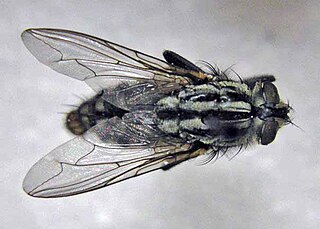
Sarcophaga pernix, also known as the red-tailed flesh fly, is a fly in the Sarcophagidae family. This fly often breeds in carrion and feces, making it a possible vector for disease. The larvae of this species can cause myiasis, as well as accidental myiasis. It is potentially useful in forensic entomology.
Compsomyiops callipes, previously known as Paraluclia wheeleri, is a member of the blowfly family Calliphoridae. It is a warm weather fly that can be found in southwestern parts of the United States and parts of South America. This species can be identified by its chaetotaxy, metallic blue color, club-shaped palp, and brown calypters.

Synthesiomyia nudiseta is one of the largest flies in the family Muscidae. The fly has a pair of forewings; the paired hind wings have been reduced to halteres that help with stability and movement during flight. Key characteristics of this species include plumose segmented aristae, well-developed calypters, and sternopleural bristles. Synthesiomyia nudiseta is a forensically important species because it is necrophilous and can therefore help determine the time of colonization for the post mortem interval with its known life cycle.

Calliphora livida is a member of the family Calliphoridae, the blow flies. This large family includes the genus Calliphora, the "blue bottle flies". This genus is important in the field of forensic entomology because of its value in post-mortem interval estimation.

Lucilia coeruleiviridis, formerly Phaenecia coeruleiviridis, is commonly known as a green bottle fly, because of its metallic blue-green thorax and abdomen. L. coeruleiviridis was first discovered by French entomologist Pierre-Justin-Marie Macquart in 1855. It belongs to the family Calliphoridae and is one of many forensically important Diptera, as it is often found on decaying substances. L. coeruleiviridis is one of the most ubiquitous blow fly species in the southeastern United States, particularly in the spring and fall months.
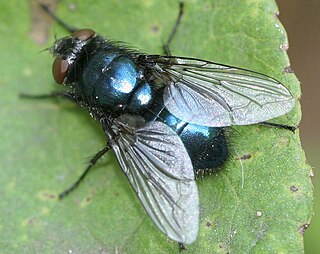
Protophormia terraenovae is commonly called northern blowfly, blue-bottle fly or blue-assed fly. It is distinguished by its deep blue coloration and large size and is an important species throughout the Northern Hemisphere. This fly is notable for its economic effect as a myiasis pest of livestock and its antibiotic benefits in maggot therapy. Also of interest is P. terraenovae’s importance in forensic investigations: because of their temperature-dependent development and their prominent presence on corpses, the larvae of this species are useful in minimum post-mortem interval (mPMI) determination.
Calliphora latifrons is a species of blue bottle fly.
Calliphora loewi is part of the family Calliphoridae, bottle flies and blowflies, and in the genus Calliphora, blue bottle flies. The genus can be deceiving since C. loewi is not blue. Though this species is rare, it can play an important part in forensic entomology, spreading disease, and decomposing carrion. The life cycle of C. loewi is similar to the life cycle of the genus Calliphora. Since this species is rare there has not been very much research done with this species.

Muscina stabulans, commonly known as the false stable fly, is a fly from the family Muscidae.
